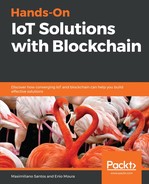Let’s take a more in-depth look at what blockchain really is. An asset consists of anything that is capable of being owned or controlled to produce value. The assets are the protagonists of this network, and can include tangible assets such as cars, houses, or money. They can also include intangible assets such as copyrights and patents. If the assets are the protagonist, then the ledger is the key. The ledger is a business's system of records. Businesses will have multiple ledgers for multiple business networks in which they participate.
The following diagram represents the status quo for business networks. Each participant keeps their own ledger(s), which are updated to represent business transactions as they occur:

With blockchain technology, members of a business network share a ledger that is updated every time a transaction occurs through peer-to-peer replication, as depicted in the following diagram:

Blockchain allows multiple competing parties to securely interact with the same universal source of truth. It has shared immutable ledgers for recording transaction history, which provide a permissioned network with known identities.
The four important concepts of blockchain are as follows:
- Consensus: For a transaction to be valid, all participants must agree on its validity.
- Provenance: Participants know where the asset came from and how its ownership has changed over time.
- Immutability: No participant can tamper with a transaction after it has been recorded in the ledger. If a transaction was made in error, a new transaction must be used to reverse the error, and both transactions are then visible.
- Finality: A single shared ledger provides one place to go to determine the ownership of an asset or the completion of a transaction.
The main focus when we talk about blockchain is on a business network based on Blockchain, Blockchain for business, where transactions and members are permissioned, private, and prioritized; we are working with assets, identity, and selective endorsement.
You may be familiar with the idea that blockchain is a Bitcoin technology. In fact, we may even say that Bitcoin was the first use case of blockchain. Bitcoin is a digital currency with no central banks, no single administrator, and no paper currency. The software used is capable of solving mathematical puzzles in a peer-to-peer network. The transactions do not have an intermediary; they happen directly between users with transparency.
